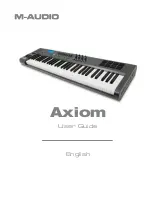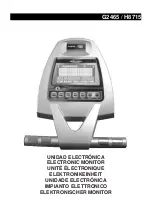
214
The main L/MONO and R outputs of the TRITON Extreme
are output from the AUDIO OUTPUT (MAIN) L/MONO
and R jacks, the S/P DIF OUT (MAIN) jack, and the head-
phone jack.
The TRITON Extreme is equipped with four individual
AUDIO OUTPUTs (INDIVIDUALs). You can route the oscil-
lator (Program), timbre (Combination), and track
(Sequencer) output or the post-IFX signals to these four indi-
vidual outputs.
Use “BUS Select” of the P8: “Routing” page in Program,
Combination, Sequencer, or Song Play mode to route the
oscillators (Program), timbres (Combination), or tracks
(Sequencer, Song Play) to AUDIO OUTPUTs (INDIVID-
UAL). If you are using the Insert Effects, use “BUS Select”
of the P8: Insert FX page to route the post-IFX signals.
1, 2, 3(Tube), 4(Tube):
Mono signals are routed to AUDIO
OUTPUTs (INDIVIDUAL).
1/2, 3/4(Tube):
Stereo signals are routed to AUDIO OUT-
PUTs (INDIVIDUAL). Use AUDIO OUTPUTs (INDIVID-
UAL) 1/2 in stereo for 1/2, and use AUDIO OUTPUTS
(INDIVIDUAL) 3/4 in stereo for 3/4.
Valve Force is an analog circuit that uses a 12AU7 (ECC82)
vacuum tube. The single vacuum tube supports stereo-in/
stereo-out processing.
It produces the rich harmonics and smooth distortion that is
characteristic of vacuum tubes, creating natural warmth and
a fat sense of drive.
1. Placement
The “Placement” parameter in the Valve Force page speci-
fies the location of the Valve Force circuit.
If “Placement” is set to Final, the Valve Force circuit will be
placed after conversion to an analog signal by the Main Out-
put L/R output DAC (Digital Analog Converter). After
passing through Valve Force, the signal is output to AUDIO
OUTPUT L/MONO, R, and headphones. VOLUME adjusts
the level after the signal has passed through Valve Force.
This placement sends the final signal of the program, combi-
nation, song, or sample playback through Valve Force, add-
ing the rich overtones and smooth distortion typical of a
vacuum tube, and unifying the sound.
If “Placement” is set to Insert (Use 3/4 BUS), the Valve Force
circuit will be placed after conversion to an analog signal by
the Indiv. Output 3/4 DAC (Digital Analog Converter). The
3/4 bus will be input to the Valve Force circuit, and will
simultaneously be output to Individual 3/4.
After passing through Valve Force, the signal is converted
by an ADC (Analog Digital Converter) back into digital
form, and sent as specified by “Pan (CC#8),” “BUS Select,”
“Send 1,” and “Send 2” to the insert effects, master effects,
L/R, Individual 1/2, or 3/4 buses.
By using Valve Force in conjunction with the insert effects
and master effects (except for sample playback) to process
the playback of a program, combination timbre, song track,
or sample, you can add the distinctively rich overtones and
smooth distortion that is characteristic of a vacuum tube.
Program, Combination, Sequencer, and Song Play modes
Main Output
Individual Outputs
Valve Force
(Digital to Analog
Converter)
(Digital to Analog
Converter)
MASTER EQ
Volume
Valve Force
On/Off
L/R BUS
Placement: Final
1/2 BUS
S/P DIF OUT
Resampling
AUDIO OUTPUT
INDIV. 1/2
AUDIO OUTPUT
L/MONO, R
Headphones
DAC
DAC
3/4 (Tube) BUS
AUDIO OUTPUT
INDIV. 3/4
DAC
VALVE FORCE
Recording Level
Digital
Analog
(Digital to Analog
Converter)
(Analog to
Digital Converter)
Valve Force
On/Off
AUDIO OUTPUT
L/MONO, R
Headphones
Resampling
Recording Level
INSERT FX
MASTER FX
Volume
3/4 (Tube) BUS
Placement: Insert (Use 3/4 BUS)
L/R BUS
AUDIO OUTPUT
INDIV. 3/4
DAC
ADC
DAC
1/2 BUS
AUDIO OUTPUT
INDIV. 1/2
DAC
VALVE FORCE
Digital
Analog
L/R BUS
1/2 BUS
Содержание TRITON Extreme
Страница 1: ...2 E ...
Страница 11: ...xii ...
Страница 111: ...100 9 5 Page Menu Command 0 1A 0 1I 0 1J Program 9 5A ...
Страница 185: ...174 ...
Страница 215: ...204 ...
Страница 281: ...270 ...
Страница 349: ...338 ...
Страница 350: ...339 ...
Страница 351: ...340 ...
Страница 352: ...341 ...
Страница 353: ...342 ...
















































